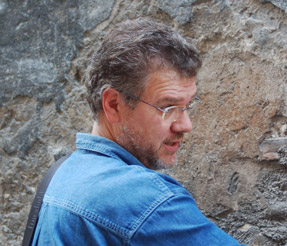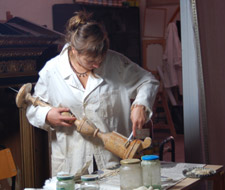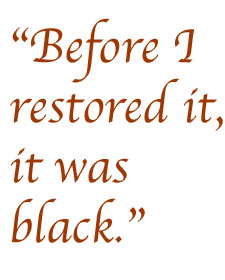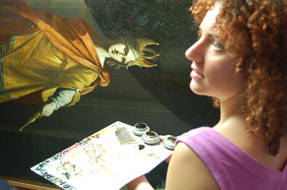Pre-eminent Restorer of Cagli’s Art Treasures
Story by Julia Gaspary
 |
| Artist Michele Papi |
Embedded
throughout the mountain town of Cagli, Italy, are unique and irreplaceable
pieces of artwork. Brightly colored stained glass windows reflect the
sunshine and ornately carved stone archways support the weight of homes
and shops. Elaborate frescoes decorate the insides of buildings, and even
some facades throughout the town.
Frescoes
are paintings created using pigment on damp plaster. The artist and his
assistants apply several layers of ever-finer plaster to a wall. Then
the painter creates his work on the final layer while it is still wet.
When the plaster dries, the picture is part of the wall.
Just as cars need to be serviced and computers need to be updated, art
needs to be restored. A combination of the elements, pollution, and natural
deterioration take their toll on the plaster masterpieces. Luckily, for
the residents and visitors of Cagli, there is a man perfect for the job.
Michele Papi, 47, has restored more than 150 pieces of art in the city
of Cagli alone.
In 1997, an earthquake shook Le Marche. The effects were devastating;
homes were ruined, shops destroyed, and many of the region’s churches
were badly hit. Consequently, a significant amount of artwork was damaged.
“Rome gave the Marche region and Umbria a certain amount of money
to repair the damage from the earthquake,” says Alberto Mazzachera,
an art historian and vice mayor of Cagli. “That budget was not enough
to finish the cycle.”
As a result, a team of administrators from Cagli was organized to estimate
the cost of the remaining repairs. The team selected which of Cagli’s
many frescos and pieces of art would be restored. Different foundations,
banks, and companies in Cagli funded the remaining costs. Mazzachera estimates
that the price of repair is about 400 euro a square meter.
Papi
and his team of three assistants made most of the repairs after the earthquake.
Aside from the frescos, which must be repaired on site, most of the work
is done in a converted 14th century church set on a hilltop in Papi’s
native town of Urbino.
Inside the workshop is a jumble of canvas, statues more than 400 years
old, and completed renovations safely stored in bubble wrap.
 “Until
a couple days ago, you could hardly walk around in here,” says Papi.
He recently completed renovating 20 paintings by the artist Anastasi for
an art exhibit in Senigallia. “Until
a couple days ago, you could hardly walk around in here,” says Papi.
He recently completed renovating 20 paintings by the artist Anastasi for
an art exhibit in Senigallia.
Up
the aluminum steps of the loft is one of Papi’s assistants, Alessia
Bani. She is cleaning and re-stretching the canvas of a pair of 17th-century
paintings by an unknown artist. She has already completed the work on
one of the paintings and is in the final stages of restoring the second.
It has taken Bani two months to “cover the parts of the painting
that were worn away.” Once the second painting is restored, the
paintings will return to Cagli.
Papi, a graduate of the Accademia di Belle Arti in Urbino, specializes
in restoring anything that is painted, including frescoes. Throughout
Cagli’s Basilica Catredale are numerous examples of Papi’s
expert artistry.
 On
the outer wall of the basilica is an archway that in the 14th century
served as the main entrance to the church. When the archway was walled
up in the 18th century, the intricate details of the arch were concealed.
“I moved the entire wall back so that everyone could appreciate
the archway,” says Papi. On
the outer wall of the basilica is an archway that in the 14th century
served as the main entrance to the church. When the archway was walled
up in the 18th century, the intricate details of the arch were concealed.
“I moved the entire wall back so that everyone could appreciate
the archway,” says Papi.
While he was restoring the archway, Papi realized that some of the stones
in the archway had been taken from ancient Roman ruins, meaning that pieces
of the arch dated back to the time of Christ. That project, which he began
in 2002, took him eight months.
Above the archway is a faded fresco of the Virgin Mary and child. Six
years before he took on the project of restoring the archway, Papi worked
on the fresco. “Before I restored it, it was black. The entire project
took me three months. It was not only a matter of cleaning them, but you
have to try solvent after solvent until you find the right one to clean
this fresco,” he says.
The interior of the basilica is even more astonishing. Immediately above
the entrance are “standards,” pictures painted onto both sides
of a fabric that is a mixture of reed fiber and linen. Enormous portraits
of saints and biblical figures on canvas border the two aisles that lead
to the altar. Painted angels support the glass dome above the altar. Papi
restored each one of these magnificent pieces of art.
 The
“standards” were handed to him as tiny pieces placed in a
box. It took him three years to piece together the small fragments which
he then sewed and glued fiber by fiber. “All of the things that
you do must be able to be undone. You cannot use modern superglue, natural
glue only,” says Papi. The
“standards” were handed to him as tiny pieces placed in a
box. It took him three years to piece together the small fragments which
he then sewed and glued fiber by fiber. “All of the things that
you do must be able to be undone. You cannot use modern superglue, natural
glue only,” says Papi.
Much of the artwork had never been restored before. “All of the
paintings on each of the altars has a significant meaning,” Papi
says. “Restoring a painting on canvas is much more difficult than
restoring a fresco.”
Papi, whose favorite piece of art is Michelangelo’s Sistine Chapel,
is nowhere near the end of his restoration career. Soon he will begin
to restore the entire exterior of 115 Via Lapis, an apartment building
in Cagli that is covered in frescos. At the same time, he will continue
to restore artifacts and paintings from around the Marche region of Italy.
Thanks to Papi, the work of centuries of artists will yet again be viewed
and appreciated.
Video
by Brett Kahn
Photos by Cindy Dew
Web
Design by Alex Cirillo |

